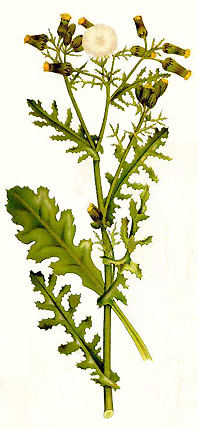| Revision as of 14:12, 22 August 2007 editNeilj (talk | contribs)346 edits Exaggeration of toxicity removed It takes a very large amount to poison.← Previous edit | Revision as of 12:47, 30 August 2007 edit undo79.75.149.162 (talk) flag contradictionNext edit → | ||
| Line 1: | Line 1: | ||
| {{contradict}} | |||
| {{Taxobox | {{Taxobox | ||
| | color = lightgreen | | color = lightgreen | ||
Revision as of 12:47, 30 August 2007
| This article or section appears to contradict itself. Please see the talk page for more information. |
| Genus: Senecio | |
|---|---|

| |
| Scientific classification | |
| Kingdom: | Plantae |
| Division: | Magnoliophyta |
| Class: | Magnoliopsida |
| Order: | Asterales |
| Family: | Asteraceae |
| Genus: | Senecio |
| Species: | S. vulgaris |
| Binomial name | |
| Senecio vulgaris L. | |
Groundsel (Senecio vulgaris) is a cosmopolitan (world-wide) annual weed of cultivation in the family Asteraceae. It is rarely found away from gardens or other areas of regularly disturbed ground. Extremely variable in all its parts, the deeply toothed leaves and slightly fleshy stems topped with rayless, yellow flower heads (capitula) and fluffy white seed heads are very familiar to gardeners everywhere. This plant can grow from seed to seeding in only a few weeks and do so in all types of soils, damp or dry.
Groundsel is used as a food plant by some Lepidoptera species including Flame Shoulder.
There are several other species of Groundsel, all of which are typically weedy but with usually more attractive flowers in as much as they have ray florets ("petals") around the margin of the flower head like most other members of the Daisy family.
Herbalism
Pliny the Elder recommended it for toothache. In folk medicine it was used to treat female complaints, especially period pain. Groundsel is an astringent, a purgative and a laxative. Large doses of groundsel can cause liver problems, and so should only be used under the guidance of a qualified herbalist.

Toxicity
Groundsel, like all species of the Senecio genus is poisonous, and advice from books on edible and medicinal plants suggest it should never be used for domestic purposes.
External links
References
- Howard, Michael. Traditional Folk Remedies (Century, 1987) p150